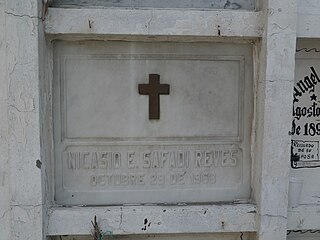Related Research Articles

Demographic features of the population of Ecuador include population density, ethnicity, education level, health of the populace, economic status, religious affiliations and other aspects of the population.
The music of Ecuador is a diverse aspect of Ecuadorian culture. Ecuadorian music ranges from indigenous styles such as pasillo to Afro-Ecuadorian styles like bomba to modern indie rock like "Cambio de Tonalidad" by Da Pawn.
Ecuador is a multicultural and multiethnic nation, with the majority of its population is descended from a mixture of both European and Amerindian ancestry. The other 10% of Ecuador's population originate east of the Atlantic Ocean, predominantly from Spain, Italy, Lebanon, France and Germany. Around the Esmeraldas and Chota regions, the African influence would be strong among the small population of Afro-Ecuadorians that account for no more than 10%. Close to 80% of Ecuadorians are Roman Catholic, although the indigenous population blend Christian beliefs with ancient indigenous customs. The racial makeup of Ecuador is 70% mestizo, 7% Amerindian, 12% White, and 11% Black.

Afro-Ecuadorians, also known as Black Ecuadorians, are Ecuadorians of predominantly Sub-Saharan African descent.
José María Egas was an Ecuadorian poet. Many of his poems were turned into the lyrics of "pasillos". Egas studied law at the University of Guayaquil graduated in 1927. He was then active as a lawyer and journalist, but became best known for his poetry, being appointed national poet laureate in 1976. He served as a professor at the University of Guayaquil. He was the brother of the poet Hugo Mayo.

Julio Alfredo Jaramillo Laurido was a notable Ecuadorian singer and recording artist who performed throughout Latin America, achieving great fame for his renditions of boleros, valses, pasillos, tangos, and rancheras.

Nicasio Safadi Reves (Reves is the translation of Rbeiz) (1902 – October 29, 1968 in Guayaquil) was an Ecuadorian musician
Luis Humberto Salgado was an Ecuadorian composer. He was regarded as one of the most influential and prolific composers of his country.
Gerardo Guevara is one of the key composers in Ecuador. His work combines native music with contemporary techniques.
Jaime Enrique Aymara Reinoso is an Ecuadorian singer and actor of tecnocumbia, tecnopaseíto bachata, national music, pasillo, pump Bolero, guayno jukebox pop music merengue, pop-flamenco, cumbia pop ballads, salsa, vallenato reggaeton and waltz. The lyrics of their songs are based on true stories of people in their country is known as "The idol of Ecuador" and "The idol of Quinceañeras", besides being much in demand in Latin concerts performed abroad as it is known for Ecuadorian emigrants.
"Nuestro juramento" is a bolero by Puerto Rican songwriter Benito de Jesús and popularized throughout Latin America by Ecuadorian singer Julio Jaramillo. Jaramillo's original recording of the song was made in 1956, featuring Rosalino Quintero on requinto guitar, and released in 1957 by Ónix. The lyrics of the song talk about two lovers who have made an oath to love each other until death and beyond; if the man dies first, the woman promises to spill all her tears over his corpse and to make everyone know about her love, and if she dies first, the man promises to write the story of their love with blood from his heart.

Carlos Aurelio Rubira Infante was an Ecuadorian singer and songwriter of pasillo and pasacalle music.
Sixto María Durán Cárdenas was an Ecuadorian pianist, composer, and lawyer.
Olga Gutiérrez Iraolagoite was an Argentine-Ecuadorian pasillo singer.
Fiebre de juventud, also known as Romance en Ecuador, is a 1966 Mexican-Ecuadorian musical comedy film directed by Alfonso Corona Blake and starring Enrique Guzmán, Begoña Palacios, Rosa María Vázquez and Fernando Luján.
Ángel Leónidas Araújo Chiriboga (1900-1993) was an Ecuadorian composer, poet, tax collector and hotelier, best known for his contributions to the pasillo genre.
Hilda Murillo Saavedra is an Ecuadorian singer, also known as "La Triunfadora de América".
Guayaquil de mis amores is an Ecuadorian song in the form of a pasillo, written by the composer Nicasio Safadi and the lyrics by Lauro Dávila. Its lyrics praise the Ecuadorian city of Guayaquil.

Fresia Raquel Saavedra Gómez was an Ecuadorian teacher and singer-songwriter. She was well known for her song "El ladrón" and for being politically and culturally active in Guayaquil through her music. In UNESCO's representative list of pasillo singing, it includes a video of a lesson by Saavedra. Pasillo was included in the Intangible Cultural Heritage of Humanity in 2021.
References
- ↑ "UNESCO - Pasillo, song and poetry". ich.unesco.org. Retrieved 2024-02-16.
- ↑ Oswald Hugo Benavides The Politics of Sentiment: Imagining And Remembering Guayaquil Page 77 2006 "In 1911, of the 272 pieces recorded in the country, 67 were pasillos, and by 1930, pasillo composers and musicians, such as Nicasio Safadi and Enrique Ibáñez Mora, were touring New York City as official representatives of the nation ..."
- ↑ Wong, Ketty. La nacionalización del pasillo ecuatoriano a principios del siglo XX. Actas del III Congreso Latinoamericano de la Asociación Internacional para el estudio de la música popular. Banco Central del Ecuador, Quito. 1999.
- ↑ Jaramillo Muñoz, Hugo; Andrade Aguirre, David. "LA MUSICA EN EL ECUADOR". janeth_haro.tripod.com.
- "MONDO LATINO - Pasillo". www.mondolatino.eu.
- Bethell, Leslie; Gordon Brotherston; Jaime Concha; Gerard Behague; Damian Bayon (1998). A Cultural History of Latin America . Cambridge University Press. p. 362. ISBN 0-521-62626-9.
- Vernon, Paul (1995). Ethnic and Vernacular Music . Greenwood Press. p. 2553. ISBN 0-313-29553-0.